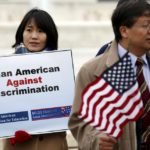| Carolyn Weaver, VoA News
New York – November 4, 2010 – Like other non-white ethnic groups from outside northern Europe and the British Isles, Chinese immigrants to America faced prejudice and exclusion for many years. In 1980, the New York Chinatown History Project was founded to collect documents, photographs and other materials telling their story. That was the beginning of the Museum of Chinese in America, which re-opened last fall at a larger site in Chinatown in downtown Manhattan. Designed by Chinese American architect Maya Lin, the new museum is built around a sky-lit, brick-walled atrium that’s meant to evoke the central courtyards of old buildings in China. Another room recreates a traditional Chinese apothecary, the kind found in Chinatowns the world over. The lead exhibit, “With a Single Step: Stories in the Making of America,” tells a history little-known either abroad or in the U.S., where only one-percent of the population is of Chinese ancestry. In the 1700s, a handful of Chinese sailors on trading ships were the first Chinese visitors to America. But beginning in the 1840s, a flood of Chinese laborers arrived to help build the cross-country railroad, starting from California. “We all know about the Chinese coming and building the railway from the West Coast, the European workers, the Irish, building the railway from the East Coast, and meeting in Promontory Point, Utah,” Museum director S. Alice Mong said in an interview. “But even before that, the Chinese were coming here to mine.” That was during the Gold Rush, when prospectors found gold in the hills and streams of the western U.S. and Canada. Poor Chinese men, drawn by the lure of what they called “Gold Mountain,” the Chinese term for California in those days, arrived in San Francisco and headed as far northwest as Alaska and British Columbia. But once the Gold Rush was over and the railway built, the laborers were no longer welcome. A new labor movement, backed by racist political groups, rallied – and sometimes rioted – against the immigrants who were seen as taking American jobs. The Chinese Exclusion Act of 1882 was the only U.S. law ever to block immigration and naturalization on the basis of national origin. At the time, says S. Alice Mong, “There was an economic recession in the United States, and the Chinese were asked to go home: ‘You’ve helped us build the railway, now go home.’ Unfortunately with many of these workers, there was no home to go to. And they could not bring their families, because they were not citizens. So, that’s kind of the genesis of Chinatown throughout the United States, [in] San Francisco, Los Angeles, New York. They became ghettos.” Racism and anti-miscegenation laws meant that Chinese immigrants could not blend in gradually, as the Irish and Italian immigrants began to do. And as Mong notes, there were few ways to make a living, other than working as a servant: “Laundry and restaurants.”
Hand laundries provided some independence for their owners, but it was hard, dirty work. The museum displays a typical iron, weighing nearly four kilograms, for pressing wrinkles out of clothing. Workers lifted them hundreds of times a day. Chinese restaurants, some with “real” Chinese food and others with bland, Americanized dishes for white visitors, were another path to independence. Popular culture portrayed Asians as mysterious, sneaky and possibly dangerous, or as comical. Hollywood’s racial codes forbade Anna May Wong, the first Chinese-American movie star, from kissing a white actor. The American-born daughter of a laundry-owner, Wong was limited to racially stereotyped roles, such as a cruel “dragon lady,” or submissive Oriental “butterfly.” S. Alice Mong says, “She died a broken woman because she never really found acceptance by America, her home. And ironically she had a chance to go back to China in the 30s, and she also didn’t find acceptance there, because the Chinese in mainland, found her role, which she could not choose, to be kind of degrading.” Laws against immigration and mixed marriages began to ease during World War II, when China was a U.S. ally. But the advent of communism in China in 1949 led to new suspicions of Chinese-Americans, and especially in the early years of the Cold War, the Federal Bureau of Investigation compiled files on many innocent citizens. Visitors like 14-year-old Maciej Buko of Florida say the museum reveals an unfamiliar history. “Most children know about the African-American segregation, and the Jim Crow laws, but no one really hears about Chinese-American segregation, or the propaganda that was against them,” he said. Race discrimination in jobs, housing and education and housing segregation remained commonplace throughout the United States in the 1950s. S. Alice Mong notes that even Asian Americans with advanced degrees couldn’t always find jobs in their field. Not until the civil rights movement of the 1960s, and the equal opportunity court cases and laws that followed, did racial barriers begin to fall.
Since then, Chinese-Americans have become prominent in every field, from the arts to science, government and athletics. Capsule biographies arrayed along the walls tell their stories, too. “Nobel-winning scientists like Steven Chu, Secretary of Energy, people like Yoyo Ma, I.M. Pei.,” Mong says. “Vera Wang, Anna Sui, Michelle Kwan. So, we’re seeing these Chinese Americans really making great strides.” She says the museum now aims to become the national museum of Chinese in America, drawing visitors from around the U.S. and abroad. Online, it sponsors theChinatown Film Project, where people from all around the world are invited to submit films about their own Chinatowns.
VoA Video
|
||
|










